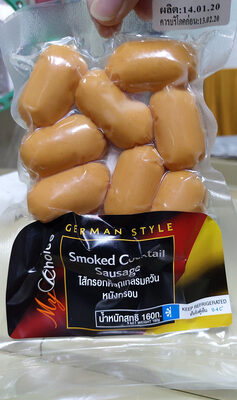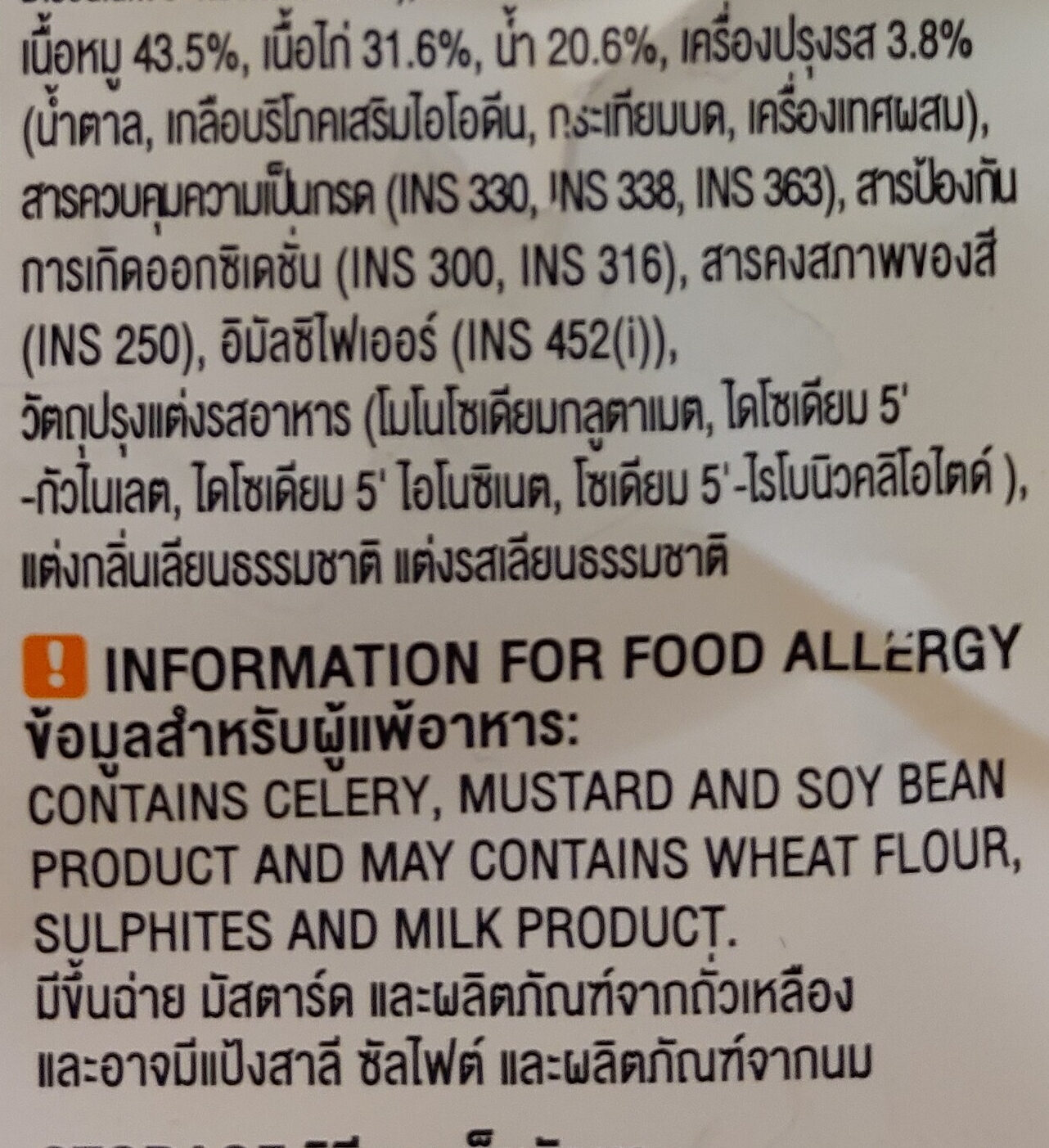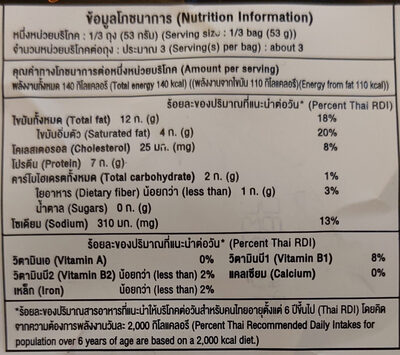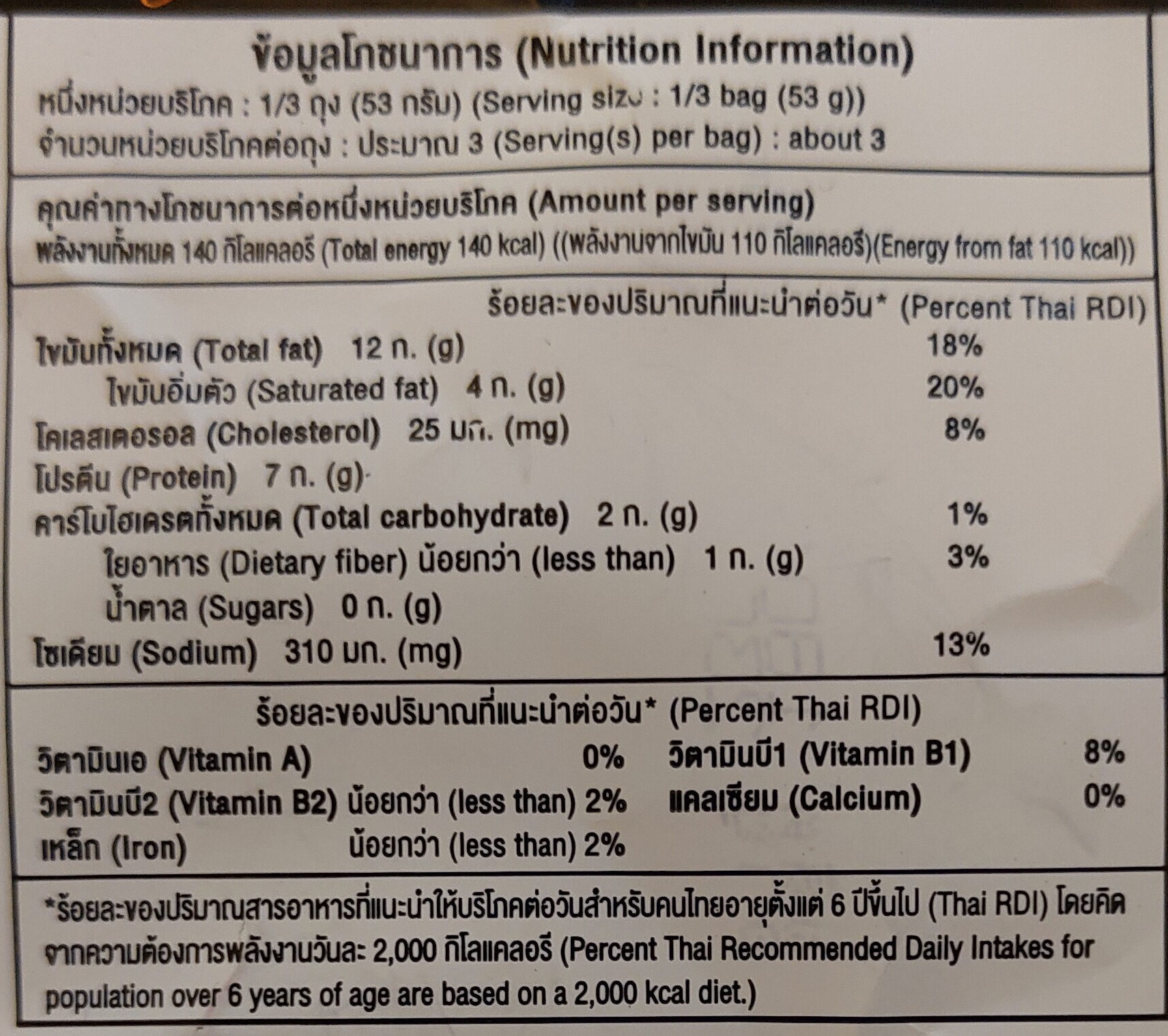Help us make food transparency the norm!
As a non-profit organization, we depend on your donations to continue informing consumers around the world about what they eat.
The food revolution starts with you!
ไส้กรอกค๊อกเทลรมควันหนังกรอบ - 160 g - My choice
ไส้กรอกค๊อกเทลรมควันหนังกรอบ - 160 g - My choice
This product page is not complete. You can help to complete it by editing it and adding more data from the photos we have, or by taking more photos using the app for Android or iPhone/iPad. Thank you!
×
Barcode: 8853474046355 (EAN / EAN-13)
Quantity: 160 g
Packaging: Pack
Brands: My choice
Categories: Meats and their products, Meats, Prepared meats, Sausages, Sausage meat
Countries where sold: Thailand
Matching with your preferences
Health
Ingredients
-
26 ingredients
: เนื้อหมู 43.5%, เนื้อไก่ 31.6%, น้ำ 20.6%, เครื่องปรุงรส 3.8% (น้ำตาล, เกลือบริโภคเสริมไอโอดีน, กระเทียมบด, เครื่องเทศผสม), สารควบคุมความเป็นกรด (INS 330, INS 338, INS 363), สารป้องกัน การเกิดออกซิเดชั่น (INS 300, INS 316), สารคงสภาพของสี (INS 250), อิมัลซิไฟเออร์ (INS 452(i)), วัตถุปรุงแต่งรสอาหาร (โมโนโซเดียมกลูตาเมต, ไดโซเดียม 5 - กัวในเลต, ไดโซเดียม 5 ไอโนชิเนต, โซเดียม 5 ไรโบนิวคลีโอไตด์ ), แต่งกลิ่นเลียนธรรมชาติ แต่งรสเลียนธรรมชาติAllergens: Celery, Gluten, Milk, Mustard, Soybeans, Sulphur dioxide and sulphites
Food processing
-
Ultra processed foods
Elements that indicate the product is in the 4 - Ultra processed food and drink products group:
- Additive: E452 - Polyphosphates
- Additive: E621 - Monosodium glutamate
Food products are classified into 4 groups according to their degree of processing:
- Unprocessed or minimally processed foods
- Processed culinary ingredients
- Processed foods
- Ultra processed foods
The determination of the group is based on the category of the product and on the ingredients it contains.
Additives
-
E250 - Sodium nitrite
Sodium nitrite: Sodium nitrite is the inorganic compound with the chemical formula NaNO2. It is a white to slightly yellowish crystalline powder that is very soluble in water and is hygroscopic. It is a useful precursor to a variety of organic compounds, such as pharmaceuticals, dyes, and pesticides, but it is probably best known as a food additive to prevent botulism. It is on the World Health Organization's List of Essential Medicines, the most important medications needed in a basic health system.Nitrate or nitrite -ingested- under conditions that result in endogenous nitrosation has been classified as "probably carcinogenic to humans" by International Agency for Research on Cancer -IARC-.Source: Wikipedia
-
E316 - Sodium erythorbate
Sodium erythorbate: Sodium erythorbate -C6H7NaO6- is a food additive used predominantly in meats, poultry, and soft drinks. Chemically, it is the sodium salt of erythorbic acid. When used in processed meat such as hot dogs and beef sticks, it increases the rate at which nitrite reduces to nitric oxide, thus facilitating a faster cure and retaining the pink coloring. As an antioxidant structurally related to vitamin C, it helps improve flavor stability and prevents the formation of carcinogenic nitrosamines. When used as a food additive, its E number is E316. The use of erythorbic acid and sodium erythorbate as a food preservative has increased greatly since the U.S. Food and Drug Administration banned the use of sulfites as preservatives in foods intended to be eaten fresh -such as ingredients for fresh salads- and as food processors have responded to the fact that some people are allergic to sulfites. It can also be found in bologna, and is occasionally used in beverages, baked goods, and potato salad.Sodium erythorbate is produced from sugars derived from different sources, such as beets, sugar cane, and corn. An urban myth claims that sodium erythorbate is made from ground earthworms; however, there is no truth to the myth. It is thought that the genesis of the legend comes from the similarity of the chemical name to the words earthworm and bait.Alternative applications include the development of additives that could be utilized as anti-oxidants in general. For instance, this substance has been implemented in the development of corrosion inhibitors for metals and it has been implemented in active packaging.Sodium erythorbate is soluble in water. The pH of the aqueous solution of the sodium salt is between 5 and 6. A 10% solution, made from commercial grade sodium erythorbate, may have a pH of 7.2 to 7.9. In its dry, crystalline state it is nonreactive. But, when in solution with water it readily reacts with atmospheric oxygen and other oxidizing agents, which makes it a valuable antioxidant.Source: Wikipedia
-
E330 - Citric acid
Citric acid is a natural organic acid found in citrus fruits such as lemons, oranges, and limes.
It is widely used in the food industry as a flavor enhancer, acidulant, and preservative due to its tart and refreshing taste.
Citric acid is safe for consumption when used in moderation and is considered a generally recognized as safe (GRAS) food additive by regulatory agencies worldwide.
-
E338 - Phosphoric acid
Phosphoric acid: Phosphoric acid -also known as orthophosphoric acid or phosphoricV acid- is a weak acid with the chemical formula H3PO4. Orthophosphoric acid refers to phosphoric acid, which is the IUPAC name for this compound. The prefix ortho- is used to distinguish the acid from related phosphoric acids, called polyphosphoric acids. Orthophosphoric acid is a non-toxic acid, which, when pure, is a solid at room temperature and pressure. The conjugate base of phosphoric acid is the dihydrogen phosphate ion, H2PO−4, which in turn has a conjugate base of hydrogen phosphate, HPO2−4, which has a conjugate base of phosphate, PO3−4. Phosphates are essential for life.The most common source of phosphoric acid is an 85% aqueous solution; such solutions are colourless, odourless, and non-volatile. The 85% solution is a syrupy liquid, but still pourable. Although phosphoric acid does not meet the strict definition of a strong acid, the 85% solution is acidic enough to be corrosive. Because of the high percentage of phosphoric acid in this reagent, at least some of the orthophosphoric acid is condensed into polyphosphoric acids; for the sake of labeling and simplicity, the 85% represents H3PO4 as if it were all in the ortho form. Dilute aqueous solutions of phosphoric acid exist in the ortho form.Source: Wikipedia
-
E363 - Succinic acid
Succinic acid: Succinic acid -- is a dicarboxylic acid with the chemical formula -CH2-2-CO2H-2. The name derives from Latin succinum, meaning amber. In living organisms, succinic acid takes the form of an anion, succinate, which has multiple biological roles as a metabolic intermediate being converted into fumarate by the enzyme succinate dehydrogenase in complex 2 of the electron transport chain which is involved in making ATP, and as a signaling molecule reflecting the cellular metabolic state. Succinate is generated in mitochondria via the tricarboxylic acid cycle -TCA-, an energy-yielding process shared by all organisms. Succinate can exit the mitochondrial matrix and function in the cytoplasm as well as the extracellular space, changing gene expression patterns, modulating epigenetic landscape or demonstrating hormone-like signaling. As such, succinate links cellular metabolism, especially ATP formation, to the regulation of cellular function. Dysregulation of succinate synthesis, and therefore ATP synthesis, happens in some genetic mitochondrial diseases, such as Leigh syndrome, and Melas syndrome, and degradation can lead to pathological conditions, such as malignant transformation, inflammation and tissue injury.Source: Wikipedia
-
E621 - Monosodium glutamate
Monosodium glutamate: Monosodium glutamate -MSG, also known as sodium glutamate- is the sodium salt of glutamic acid, one of the most abundant naturally occurring non-essential amino acids. Glutamic acid is found naturally in tomatoes, grapes, cheese, mushrooms and other foods.MSG is used in the food industry as a flavor enhancer with an umami taste that intensifies the meaty, savory flavor of food, as naturally occurring glutamate does in foods such as stews and meat soups. It was first prepared in 1908 by Japanese biochemist Kikunae Ikeda, who was trying to isolate and duplicate the savory taste of kombu, an edible seaweed used as a base for many Japanese soups. MSG as a flavor enhancer balances, blends, and rounds the perception of other tastes.The U.S. Food and Drug Administration has given MSG its generally recognized as safe -GRAS- designation. A popular belief is that large doses of MSG can cause headaches and other feelings of discomfort, known as "Chinese restaurant syndrome," but double-blind tests fail to find evidence of such a reaction. The European Union classifies it as a food additive permitted in certain foods and subject to quantitative limits. MSG has the HS code 29224220 and the E number E621.Source: Wikipedia
Ingredients analysis
-
Palm oil content unknown
Unrecognized ingredients: th:เนื้อหมู, th:เนื้อไก่, th:เครื่องปรุงรส, th:เกลือบริโภคเสริมไอโอดีน, th:กระเทียมบด, th:เครื่องเทศผสม, th:สารควบคุมความเป็นกรด, th:สารป้องกัน-การเกิดออกซิเดชั่น, th:สารคงสภาพของสี, th:อิมัลซิไฟเออร์, th:วัตถุปรุงแต่งรสอาหาร, th:ไดโซเดียม-5, th:กัวในเลต, th:ไดโซเดียม-5-ไอโนชิเนต, th:โซเดียม-5-ไรโบนิวคลีโอไตด์, th:แต่งกลิ่นเลียนธรรมชาติ-แต่งรสเลียนธรรมชาติSome ingredients could not be recognized.
We need your help!
You can help us recognize more ingredients and better analyze the list of ingredients for this product and others:
- Edit this product page to correct spelling mistakes in the ingredients list, and/or to remove ingredients in other languages and sentences that are not related to the ingredients.
- Add new entries, synonyms or translations to our multilingual lists of ingredients, ingredient processing methods, and labels.
If you would like to help, join the #ingredients channel on our Slack discussion space and/or learn about ingredients analysis on our wiki. Thank you!
-
Vegan status unknown
Unrecognized ingredients: th:เนื้อหมู, th:เนื้อไก่, th:เครื่องปรุงรส, th:เกลือบริโภคเสริมไอโอดีน, th:กระเทียมบด, th:เครื่องเทศผสม, th:สารควบคุมความเป็นกรด, th:สารป้องกัน-การเกิดออกซิเดชั่น, th:สารคงสภาพของสี, th:อิมัลซิไฟเออร์, th:วัตถุปรุงแต่งรสอาหาร, th:ไดโซเดียม-5, th:กัวในเลต, th:ไดโซเดียม-5-ไอโนชิเนต, th:โซเดียม-5-ไรโบนิวคลีโอไตด์, th:แต่งกลิ่นเลียนธรรมชาติ-แต่งรสเลียนธรรมชาติSome ingredients could not be recognized.
We need your help!
You can help us recognize more ingredients and better analyze the list of ingredients for this product and others:
- Edit this product page to correct spelling mistakes in the ingredients list, and/or to remove ingredients in other languages and sentences that are not related to the ingredients.
- Add new entries, synonyms or translations to our multilingual lists of ingredients, ingredient processing methods, and labels.
If you would like to help, join the #ingredients channel on our Slack discussion space and/or learn about ingredients analysis on our wiki. Thank you!
-
Vegetarian status unknown
Unrecognized ingredients: th:เนื้อหมู, th:เนื้อไก่, th:เครื่องปรุงรส, th:เกลือบริโภคเสริมไอโอดีน, th:กระเทียมบด, th:เครื่องเทศผสม, th:สารควบคุมความเป็นกรด, th:สารป้องกัน-การเกิดออกซิเดชั่น, th:สารคงสภาพของสี, th:อิมัลซิไฟเออร์, th:วัตถุปรุงแต่งรสอาหาร, th:ไดโซเดียม-5, th:กัวในเลต, th:ไดโซเดียม-5-ไอโนชิเนต, th:โซเดียม-5-ไรโบนิวคลีโอไตด์, th:แต่งกลิ่นเลียนธรรมชาติ-แต่งรสเลียนธรรมชาติSome ingredients could not be recognized.
We need your help!
You can help us recognize more ingredients and better analyze the list of ingredients for this product and others:
- Edit this product page to correct spelling mistakes in the ingredients list, and/or to remove ingredients in other languages and sentences that are not related to the ingredients.
- Add new entries, synonyms or translations to our multilingual lists of ingredients, ingredient processing methods, and labels.
If you would like to help, join the #ingredients channel on our Slack discussion space and/or learn about ingredients analysis on our wiki. Thank you!
-
Details of the analysis of the ingredients
We need your help!
Some ingredients could not be recognized.
We need your help!
You can help us recognize more ingredients and better analyze the list of ingredients for this product and others:
- Edit this product page to correct spelling mistakes in the ingredients list, and/or to remove ingredients in other languages and sentences that are not related to the ingredients.
- Add new entries, synonyms or translations to our multilingual lists of ingredients, ingredient processing methods, and labels.
If you would like to help, join the #ingredients channel on our Slack discussion space and/or learn about ingredients analysis on our wiki. Thank you!
: เนื้อหมู 43.5%, เนื้อไก่ 31.6%, น้ำ 20.6%, เครื่องปรุงรส 3.8% (น้ำตาล, เกลือบริโภคเสริมไอโอดีน, กระเทียมบด, เครื่องเทศผสม), สารควบคุมความเป็นกรด (e330, e338, e363), สารป้องกัน การเกิดออกซิเดชั่น (e300, e316), สารคงสภาพของสี (e250), อิมัลซิไฟเออร์ (e452i), วัตถุปรุงแต่งรสอาหาร (โมโนโซเดียมกลูตาเมต, ไดโซเดียม 5, กัวในเลต, ไดโซเดียม 5 ไอโนชิเนต, โซเดียม 5 ไรโบนิวคลีโอไตด์), แต่งกลิ่นเลียนธรรมชาติ แต่งรสเลียนธรรมชาติ- เนื้อหมู -> th:เนื้อหมู - percent: 43.5
- เนื้อไก่ -> th:เนื้อไก่ - percent: 31.6
- น้ำ -> en:water - vegan: yes - vegetarian: yes - ciqual_food_code: 18066 - percent: 20.6
- เครื่องปรุงรส -> th:เครื่องปรุงรส - percent: 3.8
- น้ำตาล -> en:sugar - vegan: yes - vegetarian: yes - ciqual_proxy_food_code: 31016
- เกลือบริโภคเสริมไอโอดีน -> th:เกลือบริโภคเสริมไอโอดีน
- กระเทียมบด -> th:กระเทียมบด
- เครื่องเทศผสม -> th:เครื่องเทศผสม
- สารควบคุมความเป็นกรด -> th:สารควบคุมความเป็นกรด
- e330 -> en:e330 - vegan: yes - vegetarian: yes
- e338 -> en:e338 - vegan: yes - vegetarian: yes
- e363 -> en:e363 - vegan: yes - vegetarian: yes
- สารป้องกัน การเกิดออกซิเดชั่น -> th:สารป้องกัน-การเกิดออกซิเดชั่น
- e300 -> en:e300 - vegan: yes - vegetarian: yes
- e316 -> en:e316 - vegan: yes - vegetarian: yes
- สารคงสภาพของสี -> th:สารคงสภาพของสี
- e250 -> en:e250 - vegan: yes - vegetarian: yes
- อิมัลซิไฟเออร์ -> th:อิมัลซิไฟเออร์
- e452i -> en:e452i - vegan: yes - vegetarian: yes
- วัตถุปรุงแต่งรสอาหาร -> th:วัตถุปรุงแต่งรสอาหาร
- โมโนโซเดียมกลูตาเมต -> en:e621 - vegan: yes - vegetarian: yes
- ไดโซเดียม 5 -> th:ไดโซเดียม-5
- กัวในเลต -> th:กัวในเลต
- ไดโซเดียม 5 ไอโนชิเนต -> th:ไดโซเดียม-5-ไอโนชิเนต
- โซเดียม 5 ไรโบนิวคลีโอไตด์ -> th:โซเดียม-5-ไรโบนิวคลีโอไตด์
- แต่งกลิ่นเลียนธรรมชาติ แต่งรสเลียนธรรมชาติ -> th:แต่งกลิ่นเลียนธรรมชาติ-แต่งรสเลียนธรรมชาติ
Nutrition
-
Poor nutritional quality
⚠ ️Warning: the amount of fruits, vegetables and nuts is not specified on the label, it was estimated from the list of ingredients: 0This product is not considered a beverage for the calculation of the Nutri-Score.
Positive points: 1
- Proteins: 5 / 5 (value: 13.2, rounded value: 13.2)
- Fiber: 1 / 5 (value: 1.89, rounded value: 1.89)
- Fruits, vegetables, nuts, and colza/walnut/olive oils: 0 / 5 (value: 0, rounded value: 0)
Negative points: 16
- Energy: 3 / 10 (value: 1110, rounded value: 1110)
- Sugars: 0 / 10 (value: 0, rounded value: 0)
- Saturated fat: 7 / 10 (value: 7.55, rounded value: 7.6)
- Sodium: 6 / 10 (value: 585, rounded value: 585)
The points for proteins are not counted because the negative points are greater or equal to 11.
Nutritional score: (16 - 1)
Nutri-Score:
-
Nutrient levels
-
Fat in high quantity (22.6%)
What you need to know- A high consumption of fat, especially saturated fats, can raise cholesterol, which increases the risk of heart diseases.
Recommendation: Limit the consumption of fat and saturated fat- Choose products with lower fat and saturated fat content.
-
Saturated fat in high quantity (7.55%)
What you need to know- A high consumption of fat, especially saturated fats, can raise cholesterol, which increases the risk of heart diseases.
Recommendation: Limit the consumption of fat and saturated fat- Choose products with lower fat and saturated fat content.
-
Sugars in low quantity (0%)
What you need to know- A high consumption of sugar can cause weight gain and tooth decay. It also augments the risk of type 2 diabetes and cardio-vascular diseases.
Recommendation: Limit the consumption of sugar and sugary drinks- Sugary drinks (such as sodas, fruit beverages, and fruit juices and nectars) should be limited as much as possible (no more than 1 glass a day).
- Choose products with lower sugar content and reduce the consumption of products with added sugars.
-
Salt in moderate quantity (1.46%)
What you need to know- A high consumption of salt (or sodium) can cause raised blood pressure, which can increase the risk of heart disease and stroke.
- Many people who have high blood pressure do not know it, as there are often no symptoms.
- Most people consume too much salt (on average 9 to 12 grams per day), around twice the recommended maximum level of intake.
Recommendation: Limit the consumption of salt and salted food- Reduce the quantity of salt used when cooking, and don't salt again at the table.
- Limit the consumption of salty snacks and choose products with lower salt content.
-
-
Nutrition facts
Nutrition facts As sold
for 100 g / 100 mlAs sold
per serving (53 g)Compared to: Sausage meat Energy 1,110 kj
(264 kcal)585.76 kj
(140 kcal)+7% Fat 22.6 g 12 g +14% Saturated fat 7.55 g 4 g +2% Cholesterol 47.2 mg 25 mg Carbohydrates 3.77 g 2 g +150% Sugars 0 g 0 g -100% Fiber 1.89 g 1 g +268% Proteins 13.2 g 7 g -15% Salt 1.46 g 0.775 g -23% Vitamin B1 (Thiamin) 15,100 mg 8,000 mg (8 % DV) Vitamin B2 (Riboflavin) 0.064 mg 0.034 mg (2 % DV) Iron 0.679 mg 0.36 mg (2 % DV) Fruits‚ vegetables‚ nuts and rapeseed‚ walnut and olive oils (estimate from ingredients list analysis) 0 % 0 %
Environment
-
Eco-Score E - Very high environmental impact
⚠ ️Select a country in order to include the full impact of transportation.The Eco-Score is an experimental score that summarizes the environmental impacts of food products.→ The Eco-Score was initially developped for France and it is being extended to other European countries. The Eco-Score formula is subject to change as it is regularly improved to make it more precise and better suited to each country.Life cycle analysis
-
Average impact of products of the same category: D (Score: 25/100)
Category: Sausage meat, raw
Category: Sausage meat, raw
- PEF environmental score: 1.27 (the lower the score, the lower the impact)
- including impact on climate change: 8.98 kg CO2 eq/kg of product
Stage Impact Agriculture
79.9 %Processing
13.6 %Packaging
4.3 %Transportation
1.3 %Distribution
0.7 %Consumption
0.2 %
Bonuses and maluses
-
Missing origins of ingredients information
Malus: -5
⚠ ️ The origins of the ingredients of this product are not indicated.
If they are indicated on the packaging, you can modify the product sheet and add them.
If you are the manufacturer of this product, you can send us the information with our free platform for producers.
-
Missing packaging information for this product
Malus: -15
⚠ ️ The information about the packaging of this product is not filled in.⚠ ️ For a more precise calculation of the Eco-Score, you can modify the product page and add them.
If you are the manufacturer of this product, you can send us the information with our free platform for producers.
Eco-Score for this product
-
Impact for this product: E (Score: 5/100)
Product: ไส้กรอกค๊อกเทลรมควันหนังกรอบ - 160 g - My choice
Life cycle analysis score: 25
Sum of bonuses and maluses: -20
Final score: 5/100
-
Carbon footprint
-
Equal to driving 4.7 km in a petrol car
898 g CO² per 100g of product
The carbon emission figure comes from ADEME's Agribalyse database, for the category: Sausage meat, raw (Source: ADEME Agribalyse Database)
Stage Impact Agriculture
82.0 %Processing
8.4 %Packaging
6.8 %Transportation
2.3 %Distribution
0.4 %Consumption
0.1 %
Packaging
-
Missing packaging information for this product
⚠ ️ The information about the packaging of this product is not filled in.Take a photo of the recycling information Take a photo of the recycling information
Transportation
-
Origins of ingredients
Missing origins of ingredients information
⚠ ️ The origins of the ingredients of this product are not indicated.
If they are indicated on the packaging, you can modify the product sheet and add them.
If you are the manufacturer of this product, you can send us the information with our free platform for producers.Add the origins of ingredients for this product Add the origins of ingredients for this product
Report a problem
-
Incomplete or incorrect information?
Category, labels, ingredients, allergens, nutritional information, photos etc.
If the information does not match the information on the packaging, please complete or correct it. Open Food Facts is a collaborative database, and every contribution is useful for all.
Data sources
Product added on by bank-pc
Last edit of product page on by mosssck.
Product page also edited by openfoodfacts-contributors, roboto-app.











